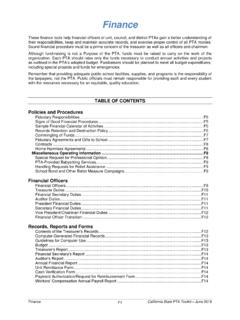Transcription of Financial Management - | University Of Al-Qadisiyah
1 Financial Management is an essential part of the economic and non economic activitieswhich leads to decide the efficient procurement and utilization of finance with profitablemanner. In the olden days the subject Financial Management was a part of accountancywith the traditional approaches. Now a days it has been enlarged with innovative andmulti dimensional functions in the field of business with the effect of industrialization, Financial Management has become a vital part of the business concern and they areconcentrating more in the field of Financial Management .
2 Financial Management alsodeveloped as corporate finance, business finance, Financial economics, Financial mathematicsand Financial engineering. Understanding the basic concept about the Financial managementbecomes an essential part for the students of economics, commerce and book provides detailed information about the finance and finance related areawith simple language and the concepts are explained with easy examples. This book is alsoprepared based on the , , , , and syllabus of variousuniversities for the benefits of the (v)
3 CHAPTER - 1 INTRODUCTION TO Financial MANAGEMENT1 10 Introduction1 Meaning of Finance1 Definition of Finance1 Definition of Business Finance2 Types of Finance2 Definition of Financial Management3 Scope of Financial Management4 Objectives of Financial Management5 Profit maximization5 Favourable arguments for profit maximization6 Unfavorable arguments for profit maximization6 Drawbacks of profit maximization6 Wealth maximization6 Favourable arguments for wealth maximization7 Unfavourable arguments for wealth maximization7 Approaches to Financial Management7 Traditional approach8 Functions of Finance Manager8 Importance of Financial Management9 Financial planning9 Acquisition of funds9 Proper use of funds10 Financial decision10 Improve profitability10 ContentsContents Increase the value of the firm10 Promoting savings10 Model Questions10 CHAPTER - 2 Financial STATEMENT ANALYSIS11 24 Introduction11 Meaning and Definition11 Income statement12 Position statement12 Statement of changes in owners equity12 Statement of
4 Changes in Financial position12 Types of Financial Statement Analysis13 Techniques of Financial Statement Analysis14 Comparative statement analysis15 Comparative balance-sheet analysis15 Comparative profit and loss account analysis16 Trend analysis17 Common size analysis17 Funds Flow Statement18 Cash Flow Statement19 Difference between funds flow and cash flow statement19 Ratio Analysis20 Liquidity ratio21 Activity ratio21 Solvency ratio22 Profitability ratio22 Model Questions24 CHAPTER - 3 SOURCES OF FINANCING25 39 Introduction25 Long-term Financial requirements or Fixed capital requirement25 Short-term Financial requirements or Working capital requirement25 Sources of Finance26 Security Finance28 Characters of security finance28 Types of security finance28 Ownership securities28 Equity Shares28 Features of equity shares28 Advantages of equity shares29 Disadvantages of equity shares30 Preference Shares30 Irredeemable preference shares31 Contents Participating preference shares31 Non-participating preference shares31
5 Convertible preference shares31 Non-convertible preference shares31 Features of preference shares31 Advantages of preference shares31 Disadvantages of preference shares32 Deferred Shares32No Par Shares32 Creditorship securities33 Debentures33 Types of debentures33 Features of debentures34 Advantages of debenture34 Disadvantages of debenture34 Internal Finance35 Depreciation funds35 Retained earnings35 Advantages of retained earnings36 Disadvantages of retained earnings36 Loan Financing37 Financial institutions37 Commercial banks37 Short-term loans38 Development banks38 Model Questions38 CHAPTER - 4 CAPITALIZATION41 45 Introduction41 Meaning of Capital41 Fixed capital41 Definition of fixed capital41 Character of fixed capital42 Working capital42 Capitalization42 Meaning of capitalization42 Definition of capitalization43 Types of Capitalization43 Over capitalization43 Causes of over capitalization43 Effects of over capitalization44 Remedies for over capitalization44 Under capitalization44 Causes of under capitalization44
6 Contents Effects of under capitalization45 Remedies of under capitalization45 Watered capitalization45 Causes of watered capital45 CHAPTER - 5 CAPITAL STRUCTURE47 64 Introduction47 Meaning of capital structure47 Definition of capital structure47 Financial Structure48 Optimum Capital Structure49 Objectives of capital structure49 Forms of capital structure49 Factors Determining Capital Structure50 Leverage50 Cost of capital50 Capital Structure Theories50 Traditional approach51 Assumptions51 Comments53 Net Income (NI) approach53 Net Operating Income (NOI)
7 Approach55 Modigliani and Miller approach58 Model Questions64 CHAPTER - 6 COST OF CAPITAL65 82 Introduction 65 Meaning of cost of capital65 Definitions65 Assumption of cost of capital66 Classification of Cost of Capital66 Explicit and implicit cost66 Average and marginal cost67 Historical and future cost67 Specific and combine cost67 Importance of Cost of Capital67 Importance to capital budgeting decision67 Importance to structure decision67 Importance to evolution of Financial performance68 Importance to other Financial decisions68 Computation of Cost of Capital68 Measurement of cost of capital68 Cost of equity68 Contents Dividend price approach68 Dividend price plus growth approach69 Earning price approach70 Realized yield approach71 Cost of debt72 Debt issued at par72 Debt issued at premium or discount72 Cost of perpetual debt and redeemable debt73 Cost of preference share capital74 Cost of retained earnings76 Measurement of overall cost of capital77 Model Questions80 CHAPTER - 7 LEVERAGE83 98 Introduction83
8 Meaning of leverage83 Definition of leverage83 Types of leverage83 Operating Leverage84 Degree of operating leverage84 Uses of operating leverage85 Financial Leverage86 Degree of Financial leverage86 Alternative definition of Financial leverage87 Uses of Financial leverage87 Distinguish Between Operating Leverage and Financial Leverage89 EBIT - EPS Break Even Chart for Three Different Financing Alternatives89 Combined Leverage90 Degree of combined leverage90 Working Capital Leverage93 Model Questions96 CHAPTER - 8 DIVIDEND DECISION99 117 Introduction99 Meaning of dividend99 Types of Dividend/Form of Dividend99 Cash dividend100 Stock dividend100 Bond dividend100 Property dividend100 Dividend Decision100 Irrelevance of Dividend101 ContentsModigliani and Miller s Approach101 Relevance of Dividend107 Walter s model107 Gordon s model111 Factors Determining Dividend Policy115 Profitable position of the firm115 Uncertainty of future income115 Legal constrains115 Liquidity position115 Sources of finance115 Growth rate of the
9 Firm115 Tax policy115 Capital market conditions115 Types of Dividend Policy116 Regular dividend policy116 Stable dividend policy116 Irregular dividend policy116 No dividend policy116 Model Questions116 CHAPTER - 9 CAPITAL BUDGETING119 147 Introduction119 Definitions119 Need and importance of capital budgeting120 Capital Budgeting Process120 Kinds of Capital Budgeting Decisions122 Methods of Capital Budgeting of Evaluation122 Pay-back period122 Un even cash inflows124 Post pay-back profitability method124 Accounting rate of return or Average rate of return126 Net present value128 Internal rate of return131 Excess present value index135 Capital rationing135 Risk and Uncertainly in Capital Budgeting136 Risk adjusted cut off rate136 Certainly equivalent method137 Sensitivity technique138 Probability technique139 Standard deviatio







